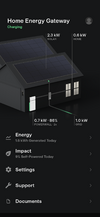I had a few issues that were stuck in tier-2 hell for several months that finally got resolved with a service visit yesterday.
But 1 issue still seems to persist. It looks like the Powerwall charge rate is capped, and the rate that it's capped at seems to fluctuate during the day.
As an example, attached screenshot shows 2.3kw solar generation, of that 0.6 going to my home, 0.7 charging Powerwalls, and 1.0 sold to grid. This is odd because all the excess solar after home usage should be entirely used to charge the Powerwalls until they reach 100pct charge. But in my particular situation, the charge rate seems to be capped at 0.7kw.
I asked the service tech about this and he said this is actually normal behavior due to the cold whether. For context, it is quite cold here right now with temps dropping to the teens during the night and in the 30s during the day.
Can someone confirm that this is in fact correct -- that the cold weather does in fact limit Powerwall charge rate? Thanks.

But 1 issue still seems to persist. It looks like the Powerwall charge rate is capped, and the rate that it's capped at seems to fluctuate during the day.
As an example, attached screenshot shows 2.3kw solar generation, of that 0.6 going to my home, 0.7 charging Powerwalls, and 1.0 sold to grid. This is odd because all the excess solar after home usage should be entirely used to charge the Powerwalls until they reach 100pct charge. But in my particular situation, the charge rate seems to be capped at 0.7kw.
I asked the service tech about this and he said this is actually normal behavior due to the cold whether. For context, it is quite cold here right now with temps dropping to the teens during the night and in the 30s during the day.
Can someone confirm that this is in fact correct -- that the cold weather does in fact limit Powerwall charge rate? Thanks.



